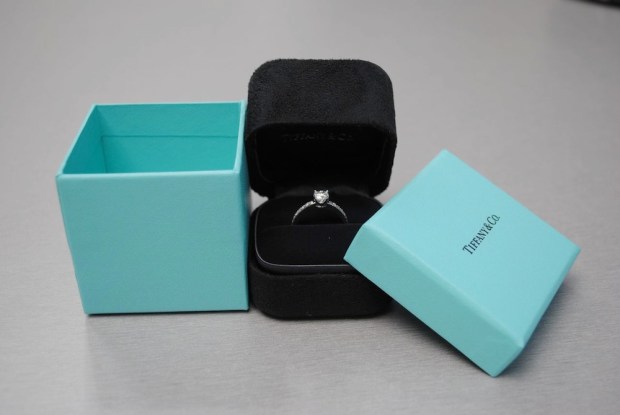Tiffany, Costco And The Complicated World Of Counterfeit

Everyone knows a Tiffany lamp when they see one — the ornate panels of decorative stained glass done in Art Nouveau style. And everyone knows it need not come care of Tiffany & Co. the internationally famous jewelers; anyone can make and market a Tiffany lamp.
One can perhaps see — if you squint a lot — how Costco thought it was going to be in the clear for marketing “Tiffany engagement rings” placed in highly distinctive powder blue boxes without actually having to get Tiffany’s permission to do so first.
It is a position it’s recently been ordered to rethink. A federal judge and jury said on Thursday (Sept. 29) that Costco Wholesale Corp. owes Tiffany $5.5 million for selling counterfeit Tiffany diamond engagement rings, plus punitive damages.
Those damages are still being decided.
Lawyers for both sides spent Friday presenting their case to the jury to set the exact amount.
And while Costco has apparently made a costly error, the fight over the rings does highlight the fact that counterfeiting is far less about faux Fendis being sold out of the backs of cars and more about genuinely grey areas about what exactly constitutes an illegal ripoff. And the stakes are rather high.
The Lord Of The Rings (Retail Retelling)
Had Costco done a few minutes of research on Wikipedia, it might have soon realized that its Tiffany lamp defense wasn’t going to hold any water. Though the lamps and the jewelry share French designer Louis Comfort Tiffany, they were historically separate enterprises. The lamps were a project of his in the late 1800s, but by the early 20th century, lamps were a sideline to his jewelry business.
Also, the “Tiffany lamp” was popularized by Tiffany, not invented by him. It was first designed in the Tiffany Studio by an uncredited woman from Ohio named Clara Driscoll.
The lamp has a complicated history — the jewelry less so. And thus, Tiffany & Co. was able to successfully argue in federal court that “Tiffany engagement ring” is not a general descriptor of a type of ring in a pretty blue box but actually designates a quality of style and design certified by Tiffany & Co.
The $5.5 million fine against Costco represents the total profit the wholesale chain earned made from the sale of the rings and is what the jury found Costco should pay for willfully infringing upon Tiffany’s trademark.
About 2,500 rings that it sold were found by the court to have infringed Tiffany’s trademark. Costco had argued at the start of the trial that ~$780,000 was the maximum it owed. Costco further argued that Tiffany’s trademarks sought to prevent others from using the word “Tiffany”as a generic description of a type of ring setting (like the lamps). The judge in the case rejected that argument, noting that Costco had instructed vendors to copy Tiffany designs and did not instruct its employees to correct customers who clearly thought they were buying rings by Tiffany & Co.
A Year Of Big-Name Battles
What Costco’s true motives were in the Tiffany marketing debacle are likely only known by its executive team and its lawyers. But grey area counterfeiting is an increasingly pressing issue, particularly as it relates to marketplaces.
Birkenstock has pulled the plug on its relationship with Amazon because it was tired of Fakenstocks on the site cutting into its business line and sullying its good name with shoddy quality.
Birkenstock USA CEO David Kahan circulated a memo internally and to its retail partners that it will be pulling its supply of products from Amazon on Jan. 1. This comes in response to what Kahan and Birkenstock claim are rampant counterfeit sandals listed for sale on the site.
Yup, Birkenstock put its open-toed foot down.
“The Amazon marketplace, which operates as an ‘open market,’ creates an environment where we experience unacceptable business practices, which we believe jeopardize our brand,” Kahan reportedly wrote in the note. “Policing this activity internally and in partnership with Amazon.com has proven impossible.”
And Kahan is not kidding. He also delivered stern warnings to its thousands of other retail partners that it would be poring over their practices to make sure they’re listing its products without the threat of counterfeits.
“We will be vigilant in handing any retail partners who choose not to comply after Jan. 1, 2017.”
That happened alongside a revolt this summer at the IACC (International AntiCounterfeiting Coalition) over Alibaba’s admission to the group that saw several top design brands, like Gucci and Michael Kors, threatening to leave rather than work with the marketplace that creates such a large platform for trading high-end fakes.
Jack Ma — clearly exasperated by the fact that Alibaba’s efforts to knock back counterfeiters aren’t more praised — rather inadvisedly noted that a lot of the problem is that the fakes are actually as good — or better — than the real thing.
“The problem is that the fake products today, they make better quality, better prices than the real products, the real names,” Ma said in Hangzhou, China. “It’s not the fake products that destroy them, it’s the new business models.”
“The exact factories, the exact raw materials, but they do not use their names,” Ma followed up.
And though Ma may not have said the right thing at the right time — considering the pitch of emotions at the time — he may have inadvertently summed up the problem that high-end trademarks are increasingly facing in the new world of marketplace-dominated commerce. Counterfeiters aren’t selling cheap knockoffs on the street. The million- and billion-dollar counterfeiters are selling at scale all over the world with goods that may literally be identical to the real deal.
